Interview with Garth Batchelor about the African Crowned Eagle in South Africa
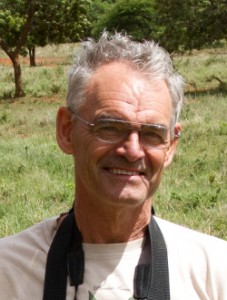
In January 2012 I was on a raptor and wildlife watching trip in South Africa with Bill Clark, Sergio Seipke and raptor enthusiasts from The Netherlands, United States and Germany. We spend more than 3 weeks visiting many great places and meeting many great people like André Botha, Peter Steyn, Rob Martin, Jessie Walton, Malcom Wilson and Ann Koeslag. We had many highlights incl. 5 species of cats, Martial Eagles, Taita Falcons, Black Harriers and much more. My personal highlight was the African Crowned Eagle. Bill managed to organize for us to meet Garth Batchelor, one of South Africa’s leading experts on the Crowned Eagle. When we met Garth on our last day in Kruger Nationalpark we already had two short and not very good glimpses of Crowned Eagles but we were hoping to get a much better view. The next day Garth took us too a beautiful place and showed us not only an almost fully fledged juvenile (see picture below) but the adult pair also appeared flying above us and we had a fantastic morning there. Garth is not only a really nice guy but he answered all my questions – and I asked a lot – with lots of fantastic information about this beautiful and powerful eagle. I am very happy that Garth agreed to do this interview and share his knowledge about the ecology and conservation of the Crowned Eagle in South Africa. The situation in South Africa gives reason for hope and with dedicated people like Garth working for the conservation of African Crowned Eagles I am optimistic for the future of Africa’s most spectacular and fascinating bird of prey.
Markus Jais, Germany
1) What is the current status of the African Crowned Eagle in South Africa?
The African Crowned Eagle is currently classified as near threatened in South Africa. This means that its population should be monitored.
2) How has the population developed during the last decades?
It is my perception that the population of this eagle have probably remained fairly constant over the past decade or more. This is due to the fact that they live in remote usually fairly densely forested, mountainous habitats. These areas are often largely inaccessible. They are also secretive birds being difficult to see during most of the year. The often sit quietly on favorite perches often in deep shade for hours waiting for prey to pass by.
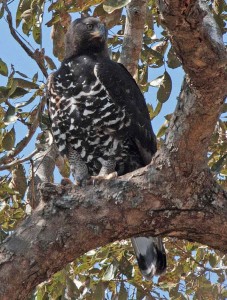
3) How does habitat destruction affect the African Crowned Eagles?
Fortunately the patches of temperate forest along the mountain ranges in South Africa are all protected. These forest patches are the favoured habitat for these large eagles and provide habitat for small antelope such as Blue and Grey Duiker as well as Bushbuck and Vervet and Samango Monkeys. In the Eastern Cape they live in thick succulent vegetation which is very thorny with many euphorbias.
4) Does illegal and maybe legal bird trade threaten the African Crowned Eagle in South Africa?
There is little recorded trade in African Crowned Eagles. Only a limited number of these eagles are kept by falconers under license. The collection of wild birds is strictly controlled by the conservation agencies.
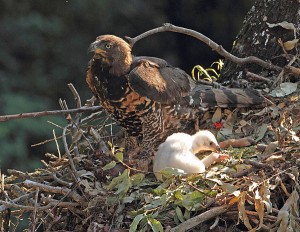
5) Are many birds shot or poisoned?
This is difficult to answer. It is probable that immature birds are shot or trapped if they hunt in urban areas or rural villages. An incident was reported to a forester by a labourer of a big bird catching and killing his small pigs. Fortunately the culprit eagle was not killed even though the nest with a chick in was less than 200 meters from the homestead. There are other reports of “urban“ eagles taking pet dogs and cats. They are definitely opportunists and will take live prey what is available that they can overpower.
6) What other threats affect the African Crowned Eagle?
Being a predator they will always come in conflict with small stock farmers. Goats are easy prey and in the Eastern cape where goats and sheep are farmed extensively farmers will shoot these eagles. In the area around Nelspruit there are a number of conservancies where antelope are farmed for hunting. The African Crowned Eagles will take the young of many antelope species including Bushbuck , Grey Rhebok and Impala. This can be difficult for the farmer to tolerate but generally they are sympathetic to the eagles.
7) What is known about the diet and food requirements of the African Crowned Eagle in South Africa?
As mentioned African Crowned Eagles are opportunists. They will take prey that is available in their territory that they can overpower. In a study on the prey items around Nelspruit in antelope formed over 70% of the diet with Vervet Monkeys also featuring highly.Other prey items included Genet Cats, mongoose, and a small porcupine. Porcupines are normally nocturnal so this is a mystery. In other areas of South Africa Rock and Tree Hyrax are selected. Birds such as Guinea Fowl and even Hadedah Ibis have been recorded as prey. The bones of prey once they have been pecked clean of muscle and sinews are dropped over the edge of the nests and these are recycled by Bush Pig and also by Porcupines.
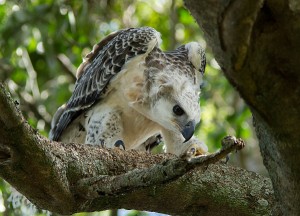
8 ) What habitat do they need? Can they live in habitat altered by humans?
African Crowned Eagles require forest with large trees. The nest tree is usually one of the tallest in the forest and can be up to 30m high. They also seem to select areas which are mountainous. This could be because they perform intense aerial displays before mating and use updrafts often associated with cliff edges to rise up quickly from where they can perform their displays. They appear to have adapted well to areas where extensive plantation so f exotic trees have been planted for timber. These trees may provide nest sites in the larger trees that have become wild in some of the drainage lines reached 30 or more metres i9n height. Pine plantations also support healthy populations of Grey Duiker which are a preferred prey item. Sub Tropical fruits are grown around Nelspruit which can attract Vervet Monkeys. As African Crowned Eagles also readily hunt Vervet Monkeys they are actually welcomed by fruit growers.
9) How large are the typical home ranges of an established pair?
Around the Nelspruit out of a sample of 40 nests, we have calculated the average territory to be about 30 square kilometers. This is small for an eagle of their size compared to a Martial eagle which has a territory size of about 250 square kilometers.
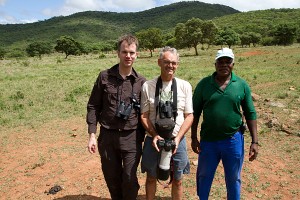
10) What is known about the dispersal and movement of juvenile and immature birds?
This is one of the big questions that we would love to answer. The fate of the juvenile birds after leaving their home territories is not known.
11) How often do African Crowned Eagles breed? How long does it take for them to raise a chick?
African Crowned Eagles have one of the longest breeding cycles of any eagle. In this respect they are similar to the Harpy Eagles of the Amazon. The nest building starts in the middle of winter, in July or early August. Egg laying can be at the end of August but is usually in September and sometimes even October. Incubation is about 51 days while the chick will take up to 110 days to fledge. I have recorded the fledged chick still being in the vicinity of the nest 9 months after fledging and still being tolerated by the adults. The long period required for the chick to become independent is presumably the reason why these eagles breed every second year. Pairs have been recorded to breed annually but we suspect that when this occurs it is because something has happened to the chick.
12) What is the average breeding success? Are there any cases with two chicks successfully fledging?
We have recorded that remote secure territories continually raise a chick every second year whereas nests close to urbanization more frequently attempt to breed annually. Without actually marking the chicks it is not possible to say definitively what is a happening to the fledged chicks but suspect there is a higher mortality of chicks closer to human settlements. We have not recorded two chicks surviving even though two eggs are usually laid .
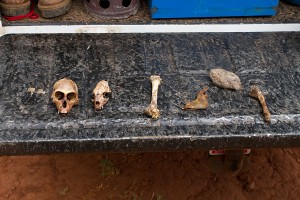
13) What is known about the relationship with other eagles like Martial Eagles or other raptor species? How are they ecologically separated?
There has been no research on this subject but suspect that African Crowned Eagles are better adapted to a forest habitat. They are like giant Goshawks with round wings and long tail making them very maneuverable in thickets. They spend most of the time sitting unobtrusively waiting for prey. Martial Eagles are master gliders spending most of the day in the air at high altitudes. They are in my view more suited to open savanna where as the Crowned Eagle is a forest specialist. This is born out by the large territories of the Martial Eagle.
14) Do Crowned Eagle benefit from private Game Farms?
They can benefit from game farms unless the owner of the farm considers them a threat to his livelihood. Most game farmers however welcome the eagles on their farms .
15) What gaps in our knowledge of this large eagle do still exists?
The biggest gap in our knowledge is knowing what happens to the immature birds after fledging. Together with this is whether some pairs or populations actually do breed annually as suggested by some researchers.
16) Where should research focus during the next years?
In trying to provide answers for the above two questions. The fitting of satellite transmitters could provide answers to these questions.
The number of nests being monitored should be expanded with ideally working groups starting up throughout their range.
17) What can and must be done to secure the survival of the African Crowned Eagle in South Africa?
Instill a greater awareness and appreciation of these birds amongst landowners who have them nesting or using their properties
18) What is the Crowned Eagle working group and what are it’s tasks and projects?
The Crowned Eagle Working Group (CEWG) consists of a few members of the local Lowveld Bird Club which is a branch of Birdlife South Africa. All landowners with African Crowned Eagle Nests on their properties are automatically members. A core group of members attempt to monitor the breeding success of each nest annually. When possible, prey remains below the nests are recorded and identified. It was realized that after starting to locate nests in the vicinity of Nelspruit that there is strong population of these eagles around the town. We are now monitoring the breeding success of 40 pairs within a radius of 70km from Nelspruit. The CEWG is working closely with all the forestry companies along the Drakensberg escarpment as well as with game farm owners advising them on the conservation of the CE.
The CEWG supported a student from the UK in 2009 to undertake a master degree on the ecology of the Crowned Eagles and would support further research initiatives.
19) How do you see the future of the African Crowned Eagle in South Africa and beyond?
With the growing awareness on these eagles by landowners and the positive support the CEWG has received over the past few years I am confident that the African Crowned Eagles around Nelspruit are in good hands. From communication we are receiving from other Provinces it would appear that this eagle is managing to maintain its populations and is even surviving in developed urban environments.
20) What was your most amazing experience with the African Crowned Eagle?
Standing on the edge of a massive cliff on the Drakensberg Escarpment at Kaapschehoop 30 km west of Nelspruit in early July 2009 I witnessed one of the most thrilling aerial displays that one could wish for. From down in the valley below a pair of African Crowned Eagles soared up in spirals until they were almost out of sight in the clouds. They then started to display calling loudly all the time. They approached closer and closer towards my wife and I till they were only meters away rolling, looping and diving through the sky.
The two following photos were taken by myself on this occasion.
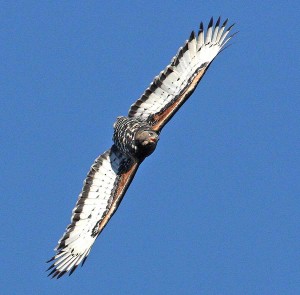
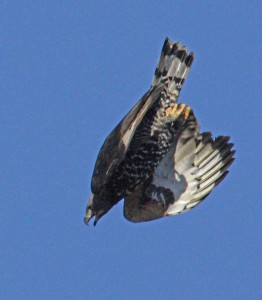

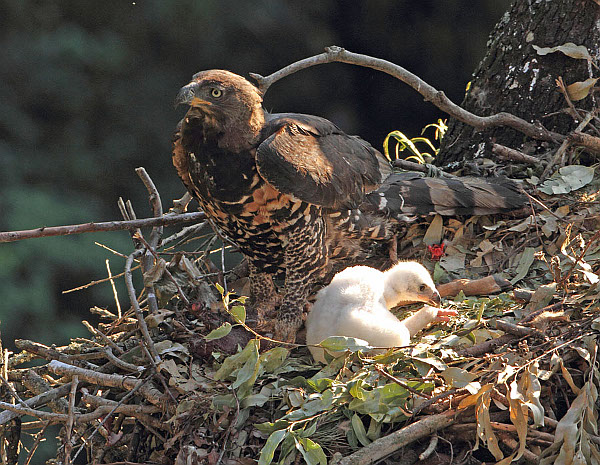
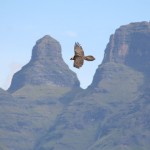


Fantastic work Garth and for Markus to highlight it like this.
I for one am a keen supporter of marking juvenile birds to really try to understand more about the dispersal patterns, if any.
Great interview. I am heading to Botswana & Zambia in Sep 2012 are there any Crowned Eagles in those areas?
We have the same problem when our White-bellied Sea-Eagles fledge we don’t know where they go we would love to know but to get permission to band is very difficult. That’s in Australia.
Hi Garth. I have been observing the most beautiful and rather large juvenile Crowned Eagle all morning. He has been resident here now in Waterfall over the last week. At the moment he is hunting a young troop of monkeys hiding out in one of my pin pine trees. He keeps flying from tree to tree and then lands in the middle and jumps from branch to branch. The monkeys are most put out as they cant move around and have their morning fun today. I am only sad that my camera with zoom is in the UK so I cannot even capture this wonderful moment and send you the pics. Regards, Shannon – Waterfall, KZN, South Africa.
I live and work on a wildlife estate outside Hoedspruit, the Blyde river flows through the estate and we have a Crowned eagle pair nesting in the riverine forest. Can you supply me with contact details of the CEWG please? Thank you, seeing these birds almost daily is a great privilege!! -Ben von Wielligh
I have been keeping my eye on a Crowned Eagle nest in Krantzkloof. 2-3 years ago they had a chick. And there is currently one that is learning to fly. I have noticed that the one from the previous season was a lot darker in colour than the one of this season. As I can’t be there every week, I am not sure if this could mean the lighter one is male or is it just an age difference that could cuase this. I LOVE watching these birds and every year I go there to see if I don’t just maybe see the nest active again!
Thank you for a very interesting article. We live in Palmiet drive Westville and the Crowned Eagles breed regularly around the corner from us. Yesterday it was amazing to hear the Crowned Eagle and Palmnut Vulture both calling within a short space of time. The Palmnut Vulture is a fairly recent arrival in our area and has also successfully bred on the banks of the Palmiet river – as you probably know they normally live up towards Mtunzini and Kosi Bay. The Crowned Eagle has feasted on a number of pets, including my son’s cat and our guinea fowl.
Im in Westville and we have a beautiful crowned eagle living here. It has preyed on a few domestic pets unfortunately. I did notice that it has been tagged with red & yellow tags